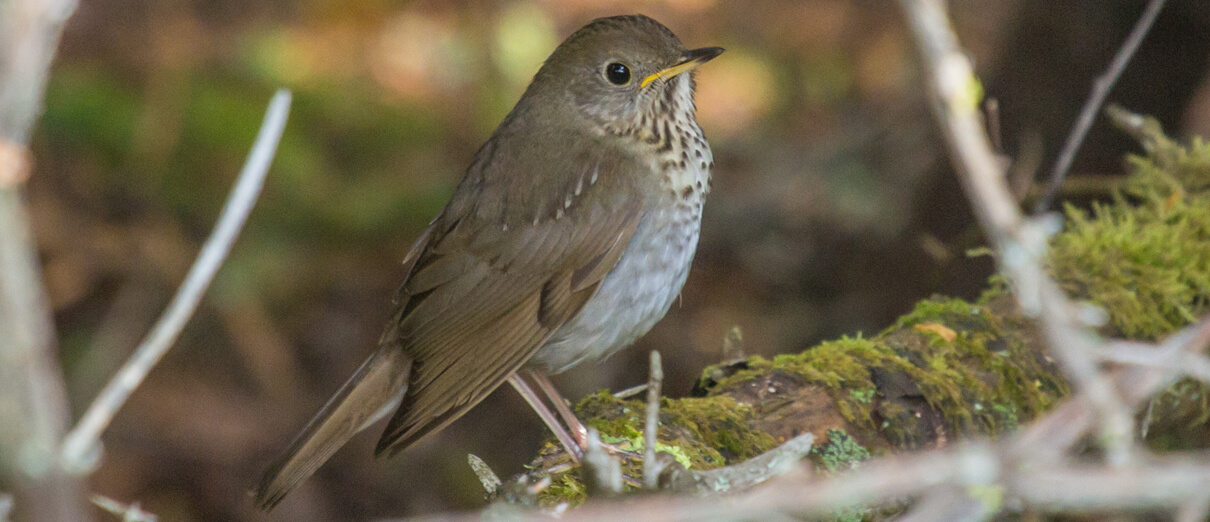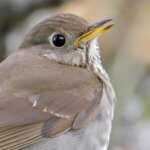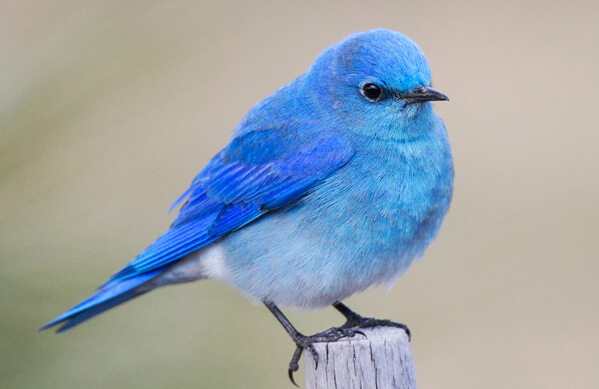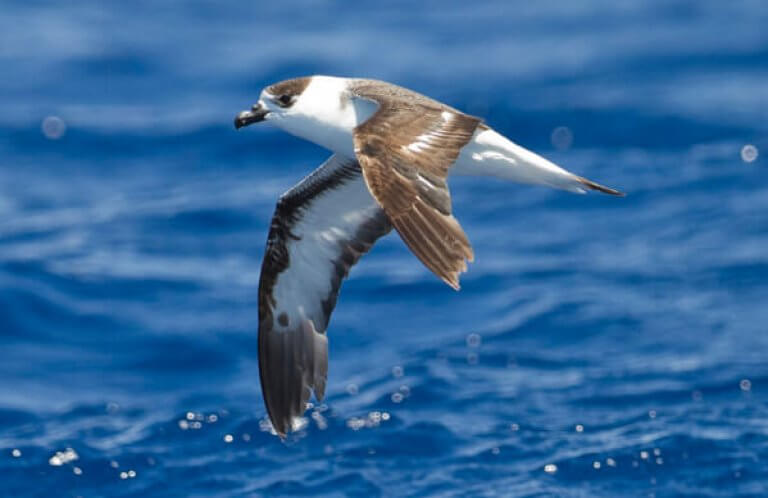About the Bicknell's Thrush
The elusive Bicknell's Thrush was once considered an isolated population of the Gray-cheeked Thrush. Then in 1995, ornithologists decided that differences in plumage, size, song, and range warranted splitting the two into distinct species. Unlike other colorful and common thrushes such as the Mountain Bluebird and American Robin, the Bicknell's Thrush has been seen by relatively few people, mostly on its remote nesting grounds.
Although it breeds and winters away from most people, keeping to the shadows, this enigmatic songbird likely can't survive without our help.
Wilderness Nester, on the Edge
Although generally known as a “forest bird,” the Bicknell's Thrush has specific habitat needs for nesting that vary across its small and scattered breeding range. For one thing, it does not nest in the forest interior, but rather favors edges created by natural disturbances, or certain types of human-caused clearing, such as for timber harvests and ski runs. One habitat component vital to this bird in many breeding areas is a thick undergrowth of young Balsam Fir trees, their growth spurred by sunlight reaching ground level after the forest canopy is opened by blowdowns, ice buildups, and clear cuts adjacent to taller forest.

The forests where these birds nest are often no taller than 15 to 25 feet. As a habitat specialist that needs specific forest conditions, this thrush recalls the Kirtland's Warbler, a bird that has been rebounding thanks to conservation on working lands that ensure large areas of young pine forest remain for this bird. A similar marriage between carefully orchestrated forestry practices and conservation would likely benefit the Bicknell's Thrush, particularly in Canada's Maritime Provinces.
The other way the Bicknell's Thrush is living on the edge: Its small breeding range and even smaller Caribbean winter range face threats including habitat loss and impacts from climate change. The International Union for Conservation of Nature ranks the species as Vulnerable, and its population is thought to be in decline.
Songs and Sounds
Brown-backed and skulking, the five North American thrushes in the genus Catharus require careful observation for reliable identification in the field. The Bicknell's and Gray-cheeked Thrushes are the most challenging to tell apart: They are “nearly identical” and “reliably distinguished only by voice,” according to David A. Sibley in his field guide.
Fortunately, what they lack in color, these thrushes make up for in voice. The two species have completely separate breeding ranges, with the more widespread Gray-cheeked nesting far to the north. Their songs are somewhat similar, yet distinct. Still, the best way to identify the Bicknell's Thrush is to hear it belt out its eerie spiraling song on nesting grounds.
Listen here:
Breeding and Feeding
Nesting in Short Trees
Male Bicknell's Thrushes arrive back on breeding grounds shortly before females return. By late May and the first week of June, mating takes place. Nesting begins in June, and a Bicknell's pair raises just one brood per season.
The female builds the nest, usually placing it low and close to the trunk in a young tree, often a fir. There, she weaves together a cup of twigs and mosses, then lines her construction with softer materials, including decomposing leaves, stringy horsehair, fungus, and sometimes grasses and other soft vegetation. She lays three to four blue-green eggs that are dappled with brown, which she alone incubates for up to two weeks. After the nestlings hatch, both parents share the duties of bringing them food.
Many breeding details about this recently split species remain to be studied.
Feeding From the Ground Up
Like others in its family, including the Wood Thrush and Swainson's Thrush, the Bicknell's Thrush often forages on or very close to the ground, gleaning invertebrates including beetles and ants. It will also sometimes dart into the air after flying insects. Especially outside nesting season, this thrush also eats berries from a variety of fruiting shrubs, trees, and vines, both during migration and on its tropical wintering grounds.
Region and Range

The Bicknell's Thrush has a spotty breeding range in the Northeast, nesting in some mountainous pockets in four U.S. states — New York, Vermont, New Hampshire, and Maine — and hilly and coastal terrain in parts of three Canadian provinces — Quebec, New Brunswick, and Nova Scotia.
Not often seen during migration, the Bicknell's Thrush winters in parts of the Caribbean, with its stronghold in the Dominican Republic. It also occurs in next-door Haiti, although less habitat remains there, and in eastern Jamaica, eastern Cuba (rare), and Puerto Rico (rare). With the wintering range even smaller than the nesting range, land-use decisions on these islands can have an out-sized impact on this Neotropical songbird.
Conservation
On Working Lands, On Protected Lands
This species faces a number of threats. Loss of its Caribbean wintering habitat is ongoing due to agricultural conversion, logging, and charcoal production. Climate change and development in forested areas are concerns, and while some forestry practices benefit the Bicknell's Thrush, others can be detrimental – such as thinning of timber stands. During migration, the thrushes sometimes are killed by collisions with glass and wind turbines.
Since 2004, ABC has been working to improve the management of Sierra de Bahoruco National Park in the Dominican Republic, an important wintering area for the Bicknell's Thrush and also home to the Endangered Black-capped Petrel, Bay-breasted Cuckoo, and Hispaniolan Crossbill, as well as the Vulnerable La Selle Thrush.

Help support ABC's conservation mission!
Most recently, ABC and in-country partners, including SOH Conservación, have improved training for park guards, involved the local community in park protection, and begun work to restore deforested areas.
ABC is also working with Fundación Loma Quita Espuela in the Cordillera Septentrional in northern Dominican Republic, another important wintering area for the Bicknell's Thrush. Research has found that a higher percentage of wintering females use the lower-altitude, drier forest here, while males are more abundant in high-elevation forest with thick understories.
Mindful stewardship on sustainable coffee and cacao farms helps to conserve habitat for wintering Bicknell's Thrushes and many other birds. For example, a 1,019-acre protected area named Zorzal Private Reserve (“zorzal” is the Spanish word for thrush), was established in 2012. Funds to manage and finance this property come from sustainable cacao production that takes place on 30 percent of the land there, so the rest can be left for wildlife.
Zorzal Cacao has been working with the Smithsonian Migratory Bird Center to blend agricultural and conservation work to benefit people and the Bicknell's Thrush and other wildlife, culminating in what is the first-ever globally certified “Bird Friendly” cacao. ABC has been supporting Zorzal Cacao in its efforts to recruit interested landowners to embrace sustainable farming and processing practices.
Get Involved
Policies enacted by the U.S. Congress and federal agencies, such as the U.S. Fish and Wildlife Service, have a huge impact on migratory birds. You can help shape these rules for the better by urging lawmakers to prioritize birds, bird habitat, and bird-friendly measures. To get started, visit ABC's Action Center.
Living a bird-friendly life can have an immediate impact on migratory birds in the United States. Doing so can be as easy as adding native plants to your garden, avoiding pesticides, and keeping cats indoors. To learn more, visit our Bird-Friendly Life page.
American Bird Conservancy and our Migratory Bird Joint Venture partners have improved conservation management on more than 8.5 million acres of U.S. bird habitat — an area larger than the state of Maryland — over the last ten years. That's not all: With the help of international partners, we've established a network of more than 100 areas of priority bird habitat across the Americas, helping to ensure that birds' needs are met during all stages of their lifecycles. These are monumental undertakings, requiring the support of many, and you can help by making a gift today.





















































